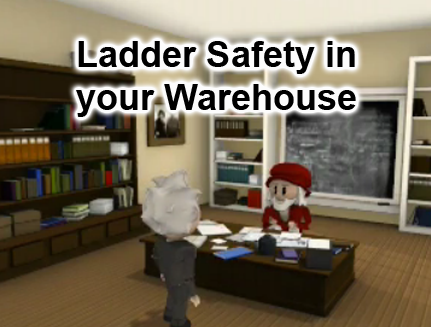Portable ladders are among the most common causes of occupational injuries in a warehouse environment. Ladders are used so frequently that it can be easy to neglect proper ladder safety when using one. To combat this, make sure the employees in your warehouse receive adequate ladder safety training.
Just what is adequate ladder safety training? OSHA (Occupational Safety and Health Administration) has outlined several guidelines to help prevent slips and falls from ladders in warehouses. We‘ve put together a short safety video that will further educate you on how to safely use ladders in your workplace including correct positioning, and basic do’s and don’ts about ladder safety. Enjoy our video on OSHA Ladder Safety.
Thanks for taking the time to learn about OSHA ladder safety training! Now you have the power to make your warehouse impervious to accidents from ladders! Remember, the more you spread this ladder safety training information, the closer we get to eliminating accidents in the warehouse. Don’t forget to visit Premier Handling solutions and check out our safety products including LOOK OUT Products, Anti-fatigue floor mats, guard rails and more!
Ladder Safety Video Transcript
Hello there. You look as if you have just witnessed an accident involving a ladder. The look on your face is unmistakable.
Yes. One of my employees fell from a ladder in my warehouse, and I witnessed it from the back of the room. It was traumatizing for all involved. How can I make sure that this never happens again in my warehouse?
Well it just so happens that I am an expert on Ladder Safety training, and I have memorized the OSHA guidelines for ladder safety.
Please tell me everything you know. I am all ears.
First, it is important that all the employees in your warehouse are educated on OSHA Ladder safety since ladders are so commonly used for so many different applications. When positioning a ladder for use, make sure the ladder has 4 solid points of contact. This means that both legs should be firmly on the ground, and the top of the ladder should be resting securely against a solid surface.
Always be conscious of the possibility of an unexpected fall, and be aware that injuries resulting from ladder falls can include broken bones or even fatalities. Make sure that no nearby obstacles could impact the ladder and cause it to fall. If possible, have another employee be a spotter while another employee is using the ladder.
To properly position a ladder, make sure the sides of an extension ladder extend 3 feet past the landing. If you do not have the recommended 3 feet of clearance past the landing, use a grab device to secure yourself. The ladder should be positioned at an angle that will not cause the ladder to slip under your own weight.
Always inspect the ladder to make sure it is not cracked or broken in any way, and report the issue if any defect is noticed. Be aware of the weight capacity of the ladder you are using. When carrying materials up and down the ladder, be especially careful not to break the weight capacity.

